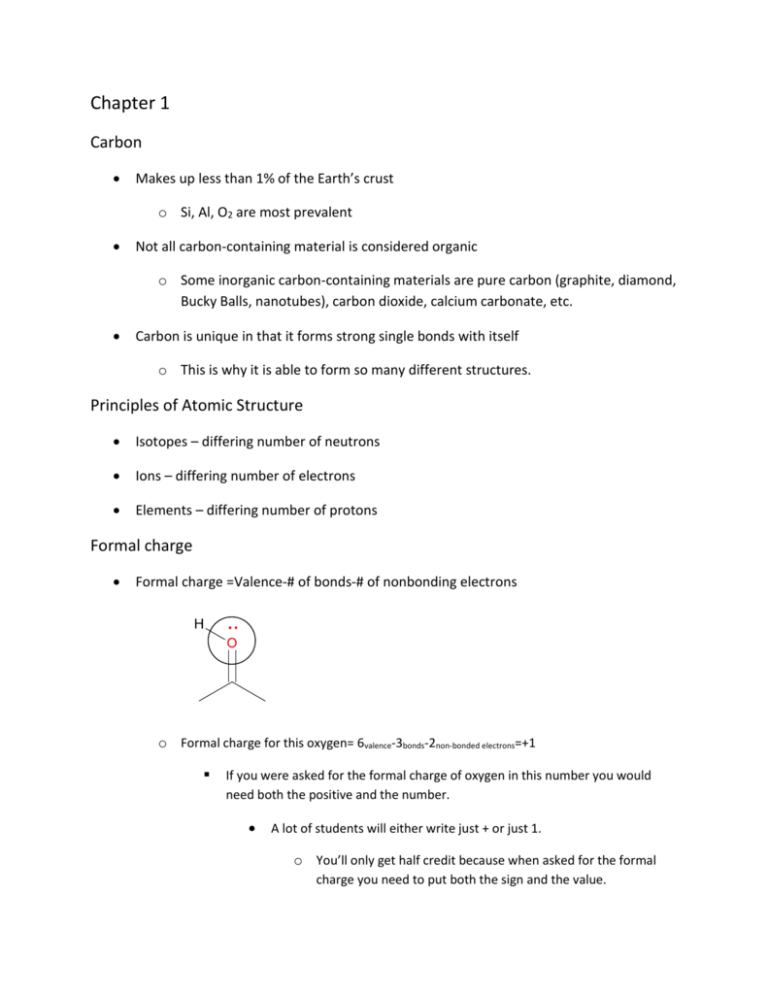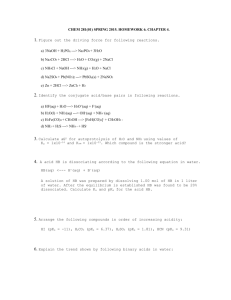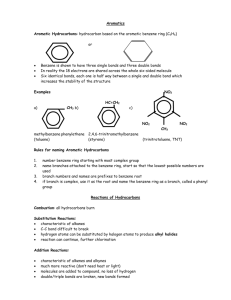Chapter 1
advertisement

Chapter 1 Carbon Makes up less than 1% of the Earth’s crust o Si, Al, O2 are most prevalent Not all carbon-containing material is considered organic o Some inorganic carbon-containing materials are pure carbon (graphite, diamond, Bucky Balls, nanotubes), carbon dioxide, calcium carbonate, etc. Carbon is unique in that it forms strong single bonds with itself o This is why it is able to form so many different structures. Principles of Atomic Structure Isotopes – differing number of neutrons Ions – differing number of electrons Elements – differing number of protons Formal charge Formal charge =Valence-# of bonds-# of nonbonding electrons o Formal charge for this oxygen= 6valence-3bonds-2non-bonded electrons=+1 If you were asked for the formal charge of oxygen in this number you would need both the positive and the number. A lot of students will either write just + or just 1. o You’ll only get half credit because when asked for the formal charge you need to put both the sign and the value. To make it easier on yourself, recognize the common bonding patterns of some commonly seen elements o The elements below those in the charts often have the same bonding patterns as those above them. Ex. Sulfur is below oxygen, and it frequently has two bonds and two lone pairs in stable, neutral compounds. Bonding patterns for common neutral,stable atoms Boron Bonds 3 Lone Pairs 0 Carbon 4 0 Nitrogen 3 1 Oxygen 2 2 Fluorine 1 3 Bonding patterns when C, N, O, or F are positively charged Bonds Lone Pairs Carbon 3 0 Nitrogen 4 0 Oxygen 3 1 Fluorine 2 2 Bonding patterns when negatively charged Boron Bonds 4 Lone Pairs 0 Carbon 3 1 Nitrogen 2 2 Oxygen 1 3 Lewis Structures We’re not going to go through and count all the electrons for these. Instead, we’re going to use the bonding patterns above. Ex. CH3COCH2CH2NH3 o “CH3” always looks like this: Fluorine 0 4 H H C H o “CH2” always looks like this: H C H o “NH3” (unless it’s just ammonia by itself” always looks like this: H N H H o If you put together what we already know, you have this H H H H H C C C N H H H H H o Inserting the carbon, gives you this H H C H C H H H C C N H H H H o Now, where do we put the oxygen? o We need to look at the bonding patterns. The carbon already has two bonds, and it needs two more bonds to make it happy. o If we put the oxygen out of the chain double-bonded to the carbon, then the carbon has its four bonds and the oxygen can have its two bonds and two lone pairs. H H O H H H C C C C N H H H H H o To finish this off, do you see which atom varies from its stable, neutral bonding pattern? Nitrogen has four bonds instead of three bonds and one lone pair, so it should be positive H H O H H H C C C C N H H H H H If you see –NH3 as a substituent, then it will always be positive. o Some groups to recognize so that drawing these will be easier Group What it looks like -CH3 H H C H -CH2- H C H -NH2 -OH 2 lone pairs on O -SH 2 lone pairs on S -NH3+ H N H H -CHO C 2 lone pairs on O -CO2C 2 lone pairs on each O (CH3)3C- CH3 CH3 C CH3 Bond Polarity To know if one bond is polar, you compare the electronegativities of the two elements o Mr. Baker often asks you at some point what two factors contribute to a bond dipole. Differences in electronegativity (if you leave off the word “differences,” you don’t get full credit) Bond length Element Li Approx. 1.0 Electronegativity Be B C N O F 1.5 2.0 2.5 3.0 3.5 4.0 To know if the molecule as a whole is polar, you have to see if the individual bonds are polar, and then see if they add up to a net dipole or if they cancel out. C C polar (net dipole drawn in) not polar because the bond dipoles cancel each other out Being able to correctly draw the structure of a molecule is very important, as that will determine whether you accurately determine the overall polarity. Ex. NH3 vs. BH3 not polar overall polar overall Ionic structures Please, please, please get this now (because it will help you later on): o When you see Na(something) or K(something), the sodium or potassium is just a spectator in organic reactions. NaOCH3 o To help you see what’s going on, I recommend crossing out the Na or K NaOCH3 o When you do that, you’ve removed the cation, so remember that the counterion must have been negatively charged, so write that in. NaOCH3 o Adding sodiums or potassiums all over a molecule in a reaction is never the right thing to do! Resonance Resonance exists when there are multiple valid Lewis structures possible for a molecule What moves? o Electrons – Which ones? Lone pairs Pi bonds o This means you will not draw an arrow moving the positive charge ever! Where do I start? o Usually there will be a positive charge somewhere in the problem. By “usually” I mean 100% of the questions I’ve ever seen Mr. Baker ask, but I say usually in case you’ve been given these notes and aren’t one of Mr. Baker’s students. o Move electrons toward that charge, because positive and negative attract o Arrows follow the movement of electrons, not charge! o Example: Draw two additional resonance contributors OH OH OH Notice that in this case the OH cannot get involved in resonance. o sp3 hybridized atoms are road blocks! sp3 OH OH sp3 How do I choose the major resonance contributor? o The Octet Rule is the most important OH o If all contributors give all atoms full octets, then you want negative charge on the most electronegative atom. Don’t reverse this for positively-charged species because that doesn’t work. o Minimize separation of charge o Maximize number of bonds (this rule is rarely helpful) Returning to the example above, choose the major resonance contributor. OH OH OH major contributor because the nitrogen has a full octet Good practice problems can be found at http://www.cabrillo.edu/~jcamara/chem12A/access/alaysas_files/Resonance_practice.pdf Empirical, Molecular, Structural, and Condensed Structural Formulas Empirical – the simplest, whole-number ratio of elements in a compound o Given the empirical formula and the molar mass, you can figure out the molecular formula. Ex. A compound of unknown molecular formula has a molar mass of 52 g/mol and an empirical formula of CH. What is it’s molecular formula? Find how much CH weighs – 12+1=13g/mol Divide 52 by 13 to get 4 The molecular formula must be C4H4 You need to know the following molar masses, as a periodic table is never given on Mr. Baker’s tests: Hydrogen=1g/mol Carbon=12g/mol Nitrogen=14g/mol Oxygen=16g/mol o You don’t have to do any of the percent analysis problems found in the book. o Ex. The empirical formula of benzene is CH Molecular – the total number of each element in a molecule of a compound o The molecular formula of benzene is C6H6 Structural – elucidates the Lewis structure of the molecule Condensed Structural o The one you’ll see the most o CH2’s in a row are counted and written (CH2)n o CH3’s connected to the same carbon are written as (CH3)n o Do not combine all CH2’s and CH3’s in the entire molecule! If this is the structure: CH3 CH3 C CH3 CH2 CH2 CH2 CH CH3 CH3 Then this is the condensed structural formula: (CH3)3C(CH2)3CH(CH3)2 Line angle drawings Also called skeletal or stick figure There’s a carbon at the end of each line segment, unless another element is written in. o One of the most common mistakes is thinking that a CH3 is just a hydrogen. Don’t do that! Hydrogens are assumed to be present in the number necessary to make the carbon neutral The structure drawn above would be Hydrogens connected to anything other than carbon must be drawn in. o It is very common for students to leave out the hydrogen connected to a heteroatom (element other than carbon or hydrogen) when asked to draw a line-angle drawing of a molecule. o Ex. Draw CH3(CH2)4CH(OH)CH3 Common wrong answer Correct answer Deuterium must still be drawn in o Deuterium is just another isotope of hydrogen, and its symbol is D You need to be very, very comfortable going back and forth between condensed structural formulae and line-angle drawings in order to be successful in this class. Acids and Bases Different definitions o Arrhenius Acids dissociate in water to give H3O+. Bases dissociate in water to give OH-. o Bronsted-Lowry Acids donate protons. Bases accept protons. o Lewis Acids accept electrons Throughout the course, we’re going to call these “electrophiles.” Bases donate electrons Throughout the course, we’re going to call these “nucleophiles.” Conjugates o The difference between two conjugates is just one proton! o Conjugate acids have one more H+ and will be more positive than the original chemical species by 1 Practice: what are the conjugate acids of H2O NH3 CH3OH NH2o Conjugate bases have one less H+ and will be more negative than the original chemical species by 1 Practice: what are the conjugate bases of H2O NH3 CH4 CH3OH Acid strength o Periodic trend When the proton of interest is bonded to different elements, acidity increases as you go left to right across the periodic table and top to bottom. Ex. Sulfur is under oxygen, so H2S is more acidic than H2O. Oxygen is to the right of nitrogen, so H2O is more acidic than NH3. o Electron-withdrawing groups near the acidic proton increase acid strength by stabilizing the conjugate base Ex. Halogens, NO2, C=O o The more electronegative the atom (or group), the more of an effect it will have. OH OH OH Of this group, the one with the chlorine would be the strongest acid because chlorine is the most electronegative. o This effect is reduced as the group is moved further from the acidic proton Ex. Which is the strongest acid? OH OH #1 is the strongest because its halogen is closest to the acidic site. o Beware of questions comparing apples and oranges! Putting halogens on an alcohol will not make it more acidic than a carboxylic acid! Ex. OH Which is the stronger acid? The answer is the bottom one, because a carboxylic acid will be stronger than an alcohol o Strong acids to know: HCl, HBr, HI H2SO4 HNO3 HClO4 o Weak acids: Everything else! Acetic acid All carboxylic acids qualify HF H3PO4 Base strength o Inversely proportional to the strength of the conjugate acid Just because an acid is weak does not mean that its conjugate is strong! The conjugate base of a weak acid is often a weak base! In the following chart, the chemical species on the left are the acids and on the right are the conjugate bases. As you can see, the conjugate of everything strong on the chart (the strong acid, HCl, and the strong base, CH3-) is weak The conjugate of something weak though, can be either strong or weak. Acetic acid and methane are both weak acids, but acetate is a weak base whereas CH3- is a very strong base. o What strong bases have we seen up until now? Hydroxide and alkoxides are the weakest of the strong bases Anything above that on the table below will be strong. pKa Ka H+ + A- HA Ka= o The higher the Ka, the stronger the acid pKa=-log(Ka) o The lower the pKa, the stronger the acid pKa Strength <0 Strong Between 0 and 5 Moderately strong (this category is still technically weak acids – they’re just the strongest of the weak acids!) 5 to 16 Moderately weak >16 Weak pKa’s you should know!!! Weakest acid Species CH4 pKa 45-50 Conjugate base CH3- Strongest acid NH3 Terminal alkyne ROH H2O Phenol RCOOH ≈35 ≈25 15-18 15.7 10 4-5 NH2Acetylide ion OROHPhenoxide RCOO- Strongest base Weakest base You don’t know what all of these are yet, so don’t worry about the ones you’ve never heard of. How do I rank a series of bases in order of their increasing or decreasing basicity? Convert to acids Find the approximate pKa of the conjugate acids o Place into categories based on the chart o If there are more than one of a given category, then rank within the category based on electron-withdrawing groups o Reverse the order of acid strength How do I determine if a base is strong enough to quantitatively deprotonate an acid? If you start from the acid in question, go across to its conjugate. The conjugate will not be strong enough and you will have an equilibrium. Any base that is stronger than the conjugate (higher on the list above), will be able to completely deprotonate the acid. Read page 31 about how to use the curved arrows!!! I haven’t seen a lot of perfect mechanisms on the tests I’ve graded, and errors on that can cost you a lot of points throughout the semester.







